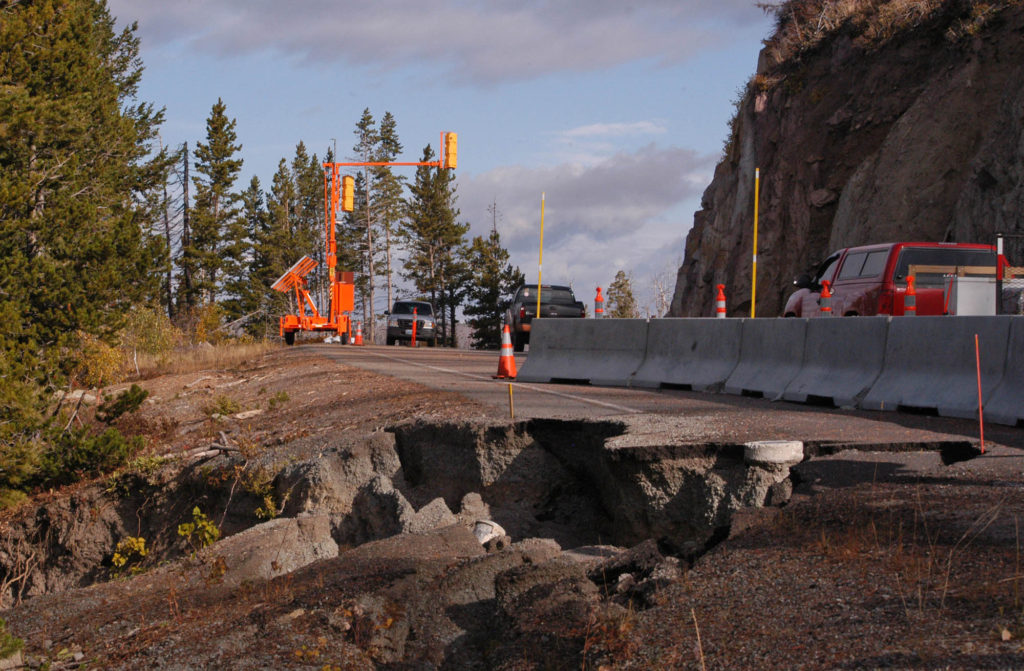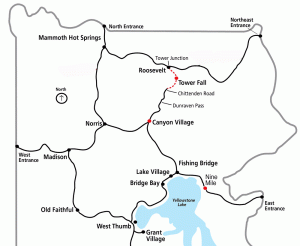
Traffic moves along a single lane of the road between Syvlan Pass and Fishing Bridge in Yellowstone National Park. A portion of the road washed away in May 2011, and long-scheduled repairs will not be made until sometime in 2013. (Ruffin Prevost/Yellowstone Gate - click to enlarge)
By Ruffin Prevost
CODY, WYO. — With just under six weeks until most roads in Yellowstone National Park close to autos for winter, a section of road near Tower Junction is being rebuilt for the first time in decades, while a damaged stretch of road east of Fishing Bridge will not be repaired this fall, as had been planned.
The road from Tower Junction to a barricade just north of the Chittenden Road turnoff on Dunraven Pass has been closed for the season to allow for a major reconstruction project, according to a statement released by the Yellowstone public affairs office.

A section of road in Yellowstone National Park near Tower Junction is being rebuilt this fall for the first time since 1939. (click to enlarge)
Visitors will be able to access Chittenden Road and the Mount Washburn area from Canyon Village to the south until that section of road closes for the season at 8 a.m., Oct. 9.
Park Officials had said earlier this year that they were planning to make repairs this fall to a partially washed-out section of road between Sylvan Pass and Fishing Bridge. Much of the eastbound lane along a section of road known as “Nine Mile,” between Lake Butte Overlook and Sedge Bay, was washed away in May 2011.
Since then, concrete barricades have closed off the damaged eastbound lane and a temporary, automated traffic signal has routed alternating two-way travel through the remaining westbound lane with minor delays, typically of five minutes or less.
Yellowstone Superintendent Dan Wenk told Cody business owners last year that it was his goal to fix the road as soon as possible, with repairs initially scheduled for fall 2011. Budget constraints and logistics complications have delayed the repairs.
Though the single-lane solution has reportedly worked well, some Cody merchants remain nervous that further erosion could wash out the remaining lane, and worry about ongoing delays for repairs.
“I give them credit for being able to keep one lane open with minimal delays, and we certainly appreciate that,” said Scott Balyo, executive director of the Cody Country Chamber of Commerce. “But obviously, we would have hoped that it would be fixed this fall.”
Heavy spring snowmelt and precipitation in 2011, along with wave action from Yellowstone Lake, washed out a portion of the road, requiring a large retaining wall as part of the proposed repairs, which are likely to cost more than $1 million. Park officials had hoped to add the job onto the Tower area road reconstruction project already under way.
But bids “came in well above our estimates and available budget, and a contract was not awarded,” said Yellowstone spokesman Al Nash in an email. Nash said the National Park Service would solicit new bids for the Nine Mile repairs “at some point in the future.”
With spring traditionally a poor time to work on roads in the park due to wet conditions, and peak summer traffic making construction closures and delays undesirable, it could be another year before repairs begin at Nine Mile.
“The worst-case scenario is that the rest of the road goes too, and then you’ve really got a problem,” Balyo said.
Park officials have said that federal highway engineers have installed monitoring equipment at the site and do not anticipate additional erosion or damage to the remaining lane.
Most of Yellowstone’s roads will close Nov. 5 in preparation for the winter season. The road from the park’s North Entrance at Gardiner, Mont. to Mammoth Hot Springs, Wyo. and on to Cooke City, Mont. is kept open to autos year-round.
A section of the Beartooth Highway (Highway 212) between the junction of Highway 296 and Red Lodge, Mont. closes for winter on Oct. 9.
Fall remains a favorite time for local residents to visit Yellowstone without the crowds of summer, but services and facilities are curtailed or closed in the coming weeks, and weather can be unpredictable. Road closures from early-season snow or ice are always possible.
Visitors are encouraged to call or go online for the latest information on Yellowstone area roads and amenities.
Call 307-344-2117 for updated park road information or visit the Yellowstone website for specific closing dates.
Call 888-WYO-ROAD or visit the Wyoming Department of Transportation website for Wyoming roads outside the park. Call 800-226-7623 or the Montana Department of Transportation website for Montana roads outside the park.
Gateway community websites for Gardiner, Mont., West Yellowstone, Mont., Cody, Wyo., and Jackson, Wyo. have additional information.
For winter season information, visit the Yellowstone winter planning page online.

Odd that there is no management mechanism to move money from State to Federal to National Park service when critical situations arise. Or asking the question another way with more specificity: the Nine Mile washout on the Cody road into Yellowstone is on a vital tourism corridor , yet is languishing without being repaired for another year due to NPS Yellowstone not having any extra cash on hand for such emergency contingencies ( too busy building Visitor’s Centers I suppose).
The flip side of the coin is the State of Wyoming rakes in a LOT of tax revenue from Yellowstone. The north half of the Park — including the Nine Mile washout area— is legally in Park County WY which collects lodging tax , sales tax, and I presume a Wyo state fuel tax at the pump. The States and the Feds have a variety of mutual aid and co-management policies in place for things like law enforcement, fire protection , medical emergencies, HAZ-MAT incidents, aviation disasters…it’s a long list with many MOU’s on file for contingencies. When the sewer system at the Lake Hotel area went amok a few years ago and raw sewage made it into the lake or river there, it was Wyoming DEQ who took regulatory action ,demanded a fix , and FINED Yellowstone $ 25,000 for some violation of state water quality regs. Finally , those folks who actually live in Yellowstone Park are legal Wyoming residents and vote as Wyoming residents in state of Wyoming legislative districts.
So the Bottom Line: if Yellowstone can’t or won’t fix this vital but damaged tourism corridor or has been swallowed in some bureaucratic funding tar pit , I would think it would be incumbent upon the State of Wyoming and its WY-DOT to step in and do the job. Sure, it’s a million dollar job to put a steel deck roadbed on that geologically gnarly corner, and a million dollars that YNP does not have at hand. So that leaves WYOMING to step up and cover its own tourism interests and put some skin ( and asphalt and steel ) in the game. Why not ? Wy-DOT of course will claim it’s own funding woes, but this particular bit of strategic damaged road intrinsically rises above paying for new curb and gutter in Smalltown, WY. besides, Wyoming has been taking all that tax money FROM Yellowstone for decades, and has returned mostly only grief to the Park.
The silver lining is if Wyoming did step up and facilitate fixing this ruptured road , then Yellowstone management would owe us one.
Dear Ruffin,
“Wave action” from the lake??????? This segment of road is 100-200 feet above the lake. Furthermore, the lake was frozen solid when this TSUNAMI was to have hit the pavement in May 2011.
I am curious, did they – Al Nash, et. al. – tell you of the “wave action” or did you make this assumption on your own?
For the record, on October 13, 2008 a drilling rig punched holes in the road and installed motion sensors for the purpose of researching and monitoring the caldera, which, according to NPS maps, crosses the road exactly where the holes were drilled. It was the holes and the subsequent cracking of the asphalt that caused the road to cave in.
The NPS did that damage – or at a minimum approved the work. Where is the investigative reporting?
“Nine Mile”??? How about a new name for the area – Tsunami Point. Or, how ’bout NINE YEAR!!!!!!!
Steve Torrey
Cody, Wyoming
Steve,
The explanation for the washout from Dan Hottle at YNP public affairs is wave action and spring runoff, not an assumption on my part.
I haven’t measured, but I think 200 feet above lake level is probably much higher than what my estimate would be for the site in question.
If you have some specifics (documents, etc.) on the Oct. 13, 2008 drilling at the site, I would be happy to take a look at whatever you can share.
-Ruffin